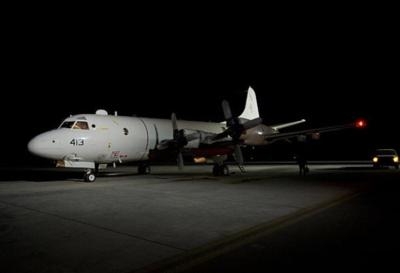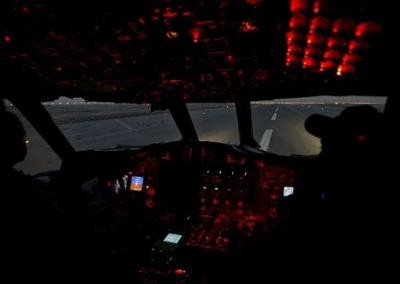Aircraft Replaced By P-8A Poseidon
The Patrol Squadron (VP) 26 "Tridents," based out of Naval Air Station Jacksonville, are currently conducting missions in the U.S. 5th Fleet area of operations. This is the Navy's final active duty deployment of the P-3C Orion aircraft from the East Coast.

The Navy is in the process of replacing the decades-old Lockheed Martin P-3C turbo-prop aircraft with the new multi-mission maritime aircraft P-8A Poseidon, a modified Boeing 737-800ERX.
Historic events aren't new to the Tridents. VP-26 was the Navy's first operational P-3 squadron when they received the first production of the P-3B, which replaced the P2-V Neptune in January 1966. Then, in 1979, VP-26 transitioned to the P-3C aircraft used today.
"It's incredible and it means being a part of history," said Lt. Cory Solis, tactical coordinator assigned to VP-26. "The plane has been a fighting force for the Navy for so long and we're still able to employ it. We can still count on her to get up in the air and be vital part of something like what we are doing now in the Middle East."
Even in the final missions of the P-3C flights, VP-26 continues to work with joint and coalition forces in the U.S. 5th Fleet area of operations. During this deployment, VP-26 has worked with British and French naval vessels and successfully executed combined operations with the Bahraini Coast Guard.
Today's P-3 is equipped with the latest Command, Control, Communications and Computer (C4) technologies to enable it to integrate with other forces and to facilitate network-centric warfare. The P-8 is designed to take these capabilities to the next level.
"The P-3 is an icon of Cold War anti-submarine warfare and it has proved extremely flexible, adapting to meet a variety of missions assigned by forward fleet commanders in the 25 years since," said Cmdr. Gregory A. Smith, commanding officer, VP-26.
Transition to a new aircraft goes beyond utilizing the physical capabilities of the aircraft and its technology.

"This flexibility is one of the hallmarks of U.S. Naval service, however, it is not the airframe that provides this flexibility," Smith said. "It is the people. The same people who are making P-3s succeed on station will be the ones who make the P-8 succeed on station. The airframe will change, but the culture and legacy of excellence in maritime patrol and reconnaissance will remain."
Personnel are already preparing for the road ahead. Sailors will have to adjust, retrain and in some cases, find a different career path in the Navy.
"My training is P-3 specific and there's not actually a spot for the in-flight technician in the P-8," said Naval Aircrewman (Avionics) 2nd Class John McDaniel, in-flight technician assigned to VP-26. "So, I will be switching platforms. I will be going to the EA-6B Prowler and will have to attend another "A" school. I have been with P-3s for five years. I feel pretty good and feel it's time to do something new."
All maintenance Sailors will be required to attend the P-8 general familiarization course, which is between five to 10 days. They will also be required to attend P-8 rate training. Upon completion, they will be assigned to Fleet Replacement Squadron, VP-30, in Jacksonville, and work in their rating specific area to become qualified collateral duty inspectors (CDI) and plane captains on the P-8 for approximately six months.
All current VP-26 operators (aircrew) identified for transition will return home and complete Category II training at VP-30, which lasts approximately six months. Upon completion of training, they will receive their new respective navy enlisted codes (NEC) and begin their first P-8 inter-deployment readiness cycle.
"You either ride the waves of change or drown beneath them," said Command Master Chief James B. Daniels Jr., command master chief, VP-26. "The point is change is going to happen whether you like it or not. The P-8 is a new, more capable aircraft, and as we did with the P-3, we will maximize the use of it to further the Navy's mission."

The new P-8 aircraft is expected to arrive in Bahrain in approximately one year.
"I am extremely proud of what the men and women of VP-26 do every day," said Smith. "They make complex and challenging evolutions seem routine. We don't set out every day to make history; we set out to do the little things the right way, the first time, to the best of our ability. Being a part of a "first" or a "last" makes it sound more special, but what is really special is the way Team Trident works together to overcome a challenge or rallies behind a shipmate who needs extra support. To me the last (P-3) deployment from the East Coast will always imply the additional work and sacrifices required to do more with less, and meeting mission in spite of those challenges; the way VP-26 has always done before."
(U.S. Navy images)
 ANN's Daily Aero-Term (04.24.24): Runway Lead-in Light System
ANN's Daily Aero-Term (04.24.24): Runway Lead-in Light System ANN's Daily Aero-Linx (04.24.24)
ANN's Daily Aero-Linx (04.24.24) Aero-FAQ: Dave Juwel's Aviation Marketing Stories -- ITBOA BNITBOB
Aero-FAQ: Dave Juwel's Aviation Marketing Stories -- ITBOA BNITBOB Classic Aero-TV: Best Seat in The House -- 'Inside' The AeroShell Aerobatic Team
Classic Aero-TV: Best Seat in The House -- 'Inside' The AeroShell Aerobatic Team Airborne Affordable Flyers 04.18.24: CarbonCub UL, Fisher, Affordable Flyer Expo
Airborne Affordable Flyers 04.18.24: CarbonCub UL, Fisher, Affordable Flyer Expo





